Feb 24, 2006
The Game Brain
Via BrainBlog
Nintendo has developed a brain-training game, "Brain Age", which presents quick mental tasks that should help keeping the brain in shape.
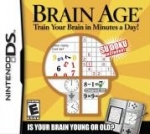
From the Nintendo website:
Activities include quickly solving simple math problems, counting people going in and out of a house simultaneously, drawing pictures on the Touch Screen, reading classic literature out loud, and more. You can also play Sudoku, the number puzzle game which has become an extremely popular feature in U.S. newspapers Brain Age is inspired by the research of Professor Ryuta Kawashima, a prominent Japanese neuroscientist. His studies evaluated the impact of performing certain reading and mathematic exercises to help stimulate the brain.
13:31 Posted in Brain training & cognitive enhancement | Permalink | Comments (0) | Tags: Positive Technology
Feb 21, 2006
Assistive technology helps disabled kids find their voice
Via Science Daily
18:45 Posted in Brain training & cognitive enhancement | Permalink | Comments (0) | Tags: Positive Technology
Feb 20, 2006
SKeeper

Tadiran LifeCare, an Israeli company, has presented a compact wearable mobile communication and safety device (SKeeper™) for the elderly. The device
enables users to carry on with their daily routines without compromising safety and well being, by enabling them to stay in touch with relatives and caregivers in case of need. With SKeeper™ elderly people get immediate assistance by simply pressing a single button on the device, and parents can rest assured that their children can easily contact them should they be lost or need assistance
...
Using its embedded Siemens MC55 wireless module and built-in speakerphone, SKeeper™ can activate cellular voice calls to pre-defined numbers (e.g. a relative or a health professional) or receive calls from anyone. When a call is made to a monitoring center, a pre-defined SMS message can be sent automatically to a relative. Incoming calls can be screened and/or answered automatically. Most of the product features, such as speed dialing numbers, auto-answering, predefined text messages, etc. are remotely programmable by the monitoring center, or by the users or their authorized relatives via a Web based interface.
13:40 Posted in Brain training & cognitive enhancement | Permalink | Comments (0) | Tags: Positive Technology
Jan 26, 2006
Developing prosthetics to treat cognitive disabilities resulting from acquired brain injuries
Developing prosthetics to treat cognitive disabilities resulting from acquired brain injuries
Neurol Res. 2002 Mar;24(2):116-24
Authors: Schiff ND, Plum F, Rezai AR
Persistent cognitive disabilities represent the most troublesome consequences of acquired brain injury. Although these problems are widely recognized, few neuroprosthetic efforts have focused on developing therapeutic strategies aimed at improving general cognitive functions such as sustained attention, intention, working memory or awareness. If possible, effective modulation of these neuropsychologic components might improve recovery of interactive behaviors. The emerging field of neuromodulation holds promise that technologies developed to treat other neurological disorders may be adapted to address the cognitive problems of patients suffering from acquired brain injuries. We here discuss initial efforts at neuromodulation in patients in the persistent vegetative state and aspects of recent studies of the underlying neurobiology of PVS and other severe brain injuries. Innovative strategies for open-loop and closed-loop neuromodulation of impaired cognitive function are outlined. We discuss the possibilities of linking neuromodulation techniques to underlying neuronal mechanisms underpinning cognitive rehabilitation maneuvers. Ethical considerations surrounding the development of these strategies are reviewed.
13:44 Posted in Brain training & cognitive enhancement | Permalink | Comments (0) | Tags: Positive Technology
Neuropsychological technologies in rehabilitation
Neuropsychological technologies in rehabilitation.
J Head Trauma Rehabil. 2002 Oct;17(5):369-77
Authors: Chute DL
OBJECTIVE: To provide an introduction and a conceptual context for the articles presented in this special edition of the Journal of Head Trauma Rehabilitation on neuropsychological technologies. SUMMARY: Many clinical assessments in neuropsychology are metamorphosing from a psychometric search for a lesion to a functional image of the working brain. Behavioral probes increasingly employ technology to provide more ecologically valid stimuli to elicit diagnostically relevant responses. Intervention strategies include an expanding range of assistive devices and technologically based treatments. The advent of the microprocessor and discipline specific programming have allowed certain aspects of rehabilitation practice to incorporate these new assessment and intervention strategies. For example, the development of neuropsychological technologies has already lead to computer based prosthetics and orthotics, cognitive probes with millisecond accurate links to functional imaging, virtual reality managed ecological assessments, cognitive retraining, assistive devices, and online, and "real-time" database-driven evaluations. Emerging technologies offer the potential for personal, portable, everyday brain imaging and rehabilitation systems. Few psychologists, physiatrists, or allied health professionals are formally trained in technological development. What has emerged thus far is a collection of individual efforts that remain to be integrated into more comprehensive tools for the rehabilitation professions. The selective history of neuropsychological technologies presented here is meant to illustrate past difficulties in the emergence of this sub-specialty and point to new applications and technological integration that may prove fruitful. The convergence of neuroengineering, adaptive assessments, everyday neuroimaging, neuroinformatics, and educational neuroimaging, presage such future developments in neuropsychological technologies.
13:40 Posted in Brain training & cognitive enhancement | Permalink | Comments (0) | Tags: Positive Technology
Jan 21, 2006
CBS News reports on neuromarketing
This report by CBS news argues that brain fitness is about to become big business. In support of this argument, the article cites the example of Posit Science, a company which has developed a brain fitness program, which is thought to improve brain functions. Though personally I do not know any scientific paper showing evidence of the effectiveness of this specific program, the founder of the company, Dr. Michael Merzenich, is a renowned neuroscientist, so I expect that the program he has developed is based on rigorous scientific foundations.
19:55 Posted in Brain training & cognitive enhancement | Permalink | Comments (0) | Tags: Positive Technology
Jan 16, 2006
IEEE-USA fosters ICT for the aging population
From the news release
The proper use of technology can improve the efficiency and quality of health care for our aging population, lower costs and perhaps improve senior citizens’ quality of life, according to a position recently adopted by IEEE-USA.
The oldest of the estimated 78.2 million baby boomers — the generation born between 1946 and 1964 — are turning 60 this year at the rate of 7,918 per day. According to the 2000 U.S. Census, the United States’ over-60 population is expected to more than quadruple over the next decade, making it critical that geriatric healthcare providers take advantage of existing and emerging technologies to improve health care for this growing segment of society.
21:34 Posted in Brain training & cognitive enhancement | Permalink | Comments (0) | Tags: Positive Technology, cognitive prosthetics
The Retinal Stimulator
Via Medgadget
A Switzerland based company has announced that its new Learning Retinal Implant System was successfully implanted in two patients in December 2005. According to the company press release (.pdf), the system, containing a 50-electrode device, is by far the most complex retinal implant tested in humans.
The System comprises three main components:

2. wears a pair of spectacles containing an integrated mini-camera and transmitter components for wireless signal and energy transmission ("The Visual Interface"). Via a cable, the spectacles are connected to:
3. "The Pocket Processor" worn at the patient's waist. This device replaces the information processing function of the formally healthy retina.
The use of a high-speed digital signal processor allows the provision of "intelligent information" to the implant (and the nerve cells) by using tuneable software to approximate the information processing normally carried out by the healthy retina. The entire process enables patients to optimize their visual perception during the learning phase. Indeed, using the patient's feedback on perception as an input for the tuning of The Pocket Processor is the unique, patent-protected feature of the System and constitutes the 'learning' capability of the Learning Retinal Implant System.
10:58 Posted in Brain training & cognitive enhancement | Permalink | Comments (0) | Tags: Positive Technology
Dec 07, 2005
Aging well with smart technology
Nurs Adm Q. 2005 Oct-Dec;29(4):329-38.
Cheek P, Nikpour L, Nowlin HD
As baby-boomers age, the need for long-term nursing care services increases. In the future, there will simply not be enough long-term care facilities to accommodate all of these patients. In addition, many people prefer to grow old at home, a concept known as aging-in-place. Smart home technology facilities aging-in-place by assisting patients with emergency assistance, fall prevention/detection, reminder systems, medication administration and assistance for those with hearing, visual or cognitive impairments. Benefits include making aging-in-place a reality, continuous monitoring, and improved psychosocial effects. Concerns of this technology include cost, availability of technology, retrofitting complications, and potential inappropriate use of the technology. Overall, the concept of smart homes is gaining in popularity and will expand the role of the nurse in the future. It is important for all nurses to understand how their practices will be transformed as smart homes become a reality for the aging population.
14:35 Posted in Brain training & cognitive enhancement | Permalink | Comments (0) | Tags: Positive Technology, Cognitive prosthetics
Dec 04, 2005
Dementia and Caregiver Quality of Life
Via Brain Blog
Thomas P, Lalloue F, Preux PM, Hazif-Thomas C, Pariel S, Inscale R, Belmin J, & Clement JP. Dementia patients caregivers quality of life: The PIXEL study. International Journal of Geriatric Psychiatry. 2005 Dec 2; [Epub ahead of print]
University Department of Psychogeriatrics & Memory Clinic CH Limoges, France.
14:10 Posted in Brain training & cognitive enhancement | Permalink | Comments (0) | Tags: Positive Technology, Cognitive prosthetics
Nov 28, 2005
Wireless care for dementia patients
Via Medical Informatics Insider
Safe at Home project has evaluated the viability and clinical effectiveness of telecare and assistive technology in supporting the independence of people with dementia.
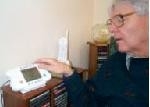
According to the project's final report, the Safe at Home project has enabled people with dementia to remain independent for longer, receiving the care and support they need in their own homes through the use of assistive technology, and has brought the local agencies in Northamptonshire equivalent savings of over £1.5 million over the 21 months during which research took place.
Emerging from ideas developed from the EU-funded ASTRID project that was led by Northamptonshire County Council, Safe at Home began as a small-scale project in 2000, and an initial evaluation published in 2002 provided evidence that supported a decision to expand the project. A second evaluation of this larger project was undertaken from June 2002 to March 2004, and involved 233 individuals and their carers. The study aimed to assess the reliability of the assistive technology used, the extent to which it supported unpaid carers, the extent to which it supported the independence of people with dementia and the cost effectiveness of the technology.
20:10 Posted in Brain training & cognitive enhancement | Permalink | Comments (0) | Tags: Positive Technology, Cognitive prosthetics
Nov 03, 2005
Using RFID tags to capture human behavior patterns
Via Smart Mobs
At WPC EXPO 2005, Tagged World Project has presented a system that captures human behavior patterns using RFID tags, stores them in an XML format, and uses the data for predicting users' future behavior patterns. The system then provides services proactively.
A scenario: everything in your room is RFID-tagged and you have a mobile RFID reader. If you forget to lock the door, the system alarts you (If you don't touch your room key before leaving the room, the system can detect it).
A similar approach has been recently proposed by Gaetano Borriello and co-workers at University of Washington. They have built a prototype of a smartwatch that works using RFID tags to help people keep track of their stuff. Here is a picture of a user walking through a doorway with several tagged objects. An RFID reader is visible on the left (white box on black stand); tags are visible on the notebooks in his hand; his personal server is in his front left pants pocket; and, our wristwatch UI is on his left wrist." Here is the link to the full paper

23:05 Posted in Brain training & cognitive enhancement | Permalink | Comments (0) | Tags: Positive Technology, Cognitive prosthetics
Oct 21, 2005
Can technology make us smarter?
Via Mind Hacks
CNET News.com interviews Mike Merzenich, a neuroscientist, on how high-tech is shaping human intelligence. Merzenich, who is also a high-tech entrepreneur, focuses on designing and developing computer applications that support cognitive skills such as memory, attention, and language processing.
In this interview, Merzenich claims that massive exposure to technologies such as video games, television and the Internet is affecting brain evolution. He observes that in each stage of cultural development human beings had to develop novel skills and abilities. The progressive accumulation of these skills determined significant changes in our central nervous system, which is now very different from the brain of our ancestors. As culture and technology are still evolving, the challenges faced by brains are continuously changing and elaborating. Starting from these premises, Merzenich suggests that continuous exercise can help to preserve and maintain cognitive skills and abilities, and assumes that brain fitness will be an important part of every future, well-organized life.
Read full article on News.com
More to explore
Merzenich's company Posit Science
18:35 Posted in Brain training & cognitive enhancement | Permalink | Comments (0) | Tags: Positive Technology, Cognitive prosthetics
Sep 28, 2005
The singularity is near
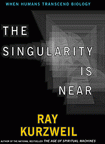 Here is a quote from a New Scientist article that sums up Kurzweil's projections:
Here is a quote from a New Scientist article that sums up Kurzweil's projections:
"Ultimately, we will merge with our technology. This will begin with nanobots in our bodies and brains. The nanobots will keep us healthy, provide full-immersion virtual reality from within the nervous system, provide direct brain-to-brain communication over the internet and greatly expand human intelligence. But keep in mind that non-biological intelligence is doubling in capability each year, whereas our biological intelligence is essentially fixed. As we get to the 2030s, the non-biological portion of our intelligence will predominate. By the mid 2040s, the non-biological portion of our intelligence will be billions of times more capable than the biological portion. Non-biological intelligence will have access to its own design and will be able to improve itself in an increasingly rapid redesign cycle."
Via smart mobs10:50 Posted in Brain training & cognitive enhancement | Permalink | Comments (0) | Tags: Positive Technology, Cognitive prosthetics
Sep 06, 2005
Intel Proactive Health Research
Can proactive systems that anticipate a patient's needs improve the quality of life for both the patients and their caregivers? Intel's Proactive Health Research group looks at how ubiquitous computing can be used in the health care industry and specifically how current technologies can be applied to help take care of the quickly growing population of senior citizens.
The project, launched in April 2002, consists of three phases:
- Phase One: Focus on physical and cognitive decline, especially on technologies that will help tomorrow's elderly population to age in place from wherever they and their families choose
- Phase Two: Address the needs of those with common chronic conditions like cancer and cardiovascular disease.
- Phase Three: Focus on wellness, including nutrition, physical fitness, and mental health.
More to explore
Intel's Proactive Health Research Initiative website
12:45 Posted in Brain training & cognitive enhancement | Permalink | Comments (0) | Tags: Positive Technology, Cognitive prosthetics
Sep 02, 2005
Enhanced cognition - the SenseCam
Via Brainblog
The SenseCam is a badge-sized wearable camera that captures up to 2000 VGA images per day into 128Mbyte Flash memory. In addition, sensor data such as movement, light level and temperature is recorded every second. 
 According to developers Lyndsay Williams, Ken Wood or Steve Hodges from the Sensors and Devices Group at Microsoft Research Cambridge (UK), the camera might have some potential as a cognitive aid device. For example, it could help with memory recall, by doing a rewind of the days events. Future SenseCams will also capture audio and possibly heart rate or other physiological data.
According to developers Lyndsay Williams, Ken Wood or Steve Hodges from the Sensors and Devices Group at Microsoft Research Cambridge (UK), the camera might have some potential as a cognitive aid device. For example, it could help with memory recall, by doing a rewind of the days events. Future SenseCams will also capture audio and possibly heart rate or other physiological data.
13:05 Posted in Brain training & cognitive enhancement | Permalink | Comments (0) | Tags: Positive Technology, Cognitive prosthetics
Aug 05, 2005
Mnemonic devices may help brain-injured patients
Mnemonics are devices that allows for classification, organization, storage and recollection of information into and out of long-term memory. In Ancient Rome, orators used mnemonics to remember the points they wanted to make in a speech. The method of remembering they used is called the Method of Loci, invented by the Greek poet Simonides about 500 B.C. Simonides was asked to recite a poem at a banquet, given by one of his patrons, and after doing so the room fell in, burying all in its debris, and disfiguring the bodies so as to render identification impossible. Simonides, however, had noted the position each guest had occupied, and was thus able to point out the remains of each. (A.E. Middleton, All About Mnemonics, London, 1885).
Modern neurosciences have showed that effectiveness of visual imagery mnemonics like Method of Loci is based on the human capability to remember objects when they are placed in a visual structured context. The literature on the use of visual imagery as a mnemonic device has consistently shown that subjects who use visual imagery to help them learn verbal material do considerably better than subjects who attempt to learn the material using simple rote repetition. Brain imaging research has shown that when visual imagery is used to learn verbal material, subjects show brain activity in systems normally involved in processing visual stimuli. The implications of these findings point to the potential learning advantage of a complex imagination.
There is clinical evidence that visual imagery mnemonics are particularly useful in remediation of memory disorders in brain-damaged patients. In particular, research suggests that such techniques can lead to improved performance on formal testing in a number of neurologic disease populations and following lesions of either the left or right hemisphere.
More to explore
Yates, F. (1966) The Art of Memory, Chicago University of Chicago Press
Richardson, J.T. (1992). Imagery mnemonics and memory remediation. Neurology 42 (2):283-286
Medical Mnemonics - A free, non-profit, online searchable database of medical mnemonics to help remember the important details
20:40 Posted in Brain training & cognitive enhancement | Permalink | Comments (0) | Tags: Positive Technology, Cognitive prosthetics
Jul 22, 2005
Smart brace to prevent falls in the elderly
Via Medgadget and Near Near Future
Stanford entrepreneurs are testing a "smart" brace to prevent falls in the elderly. The tool is fitted with a tiny chip, which continuously monitors the position of the ankle. If the chip detects a roll that is greater than normal, it begins to vibrate. 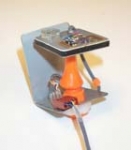
The vibrations send a signal to the brain that the person needs to change the position of their foot or shift their balance in order to avoid a fall.
More to explore:
12:25 Posted in Brain training & cognitive enhancement | Permalink | Comments (0) | Tags: Positive Technology, Cognitive prosthetics
Jun 27, 2005
Tennis for the visually impaired
From Near near future
Tennis Sensation is a tennis game that allows a wide variety of users, particularly the visually impaired, to compete fairly.
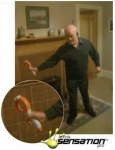
It uses spatial (3D) audio, to represent sounds at locations in space, enabling the user to locate the virtual ball. The handle of the "racquet" shows correct orientation and grip through contours and materials.
Skill and physical ability can be altered to allow use by the elderly and disabled. A handicapping level selection enables a grandparent to play with their grandchild. The game can be played by people in different locations. When gripped from the charger the product turns on and connects to the headphones automatically. It can connect through an internet connection or use the 3G phone network. Menus are navigated by tilting and options selected by squeezing the grip. Vibropads in the grip give the subtle vibrations associated with good and bad tennis shots, and haptics give the feel of a ball on the racquet at virtual impact. Banks of LEDs explode on impact, with colour representing the quality of the shot. A dedicated synthesiser generates the stereo sound and audio cues, and a Motorola RISC microprocessor performs the calculations.
13:15 Posted in Brain training & cognitive enhancement | Permalink | Comments (0) | Tags: Positive Technology, Cognitive prosthetics
Jun 21, 2005
As time goes by - New Memory Aid Helps Dementia Sufferers
Press release - Engineering and Physical Sciences Research Council (EPSRC)
PN: 14/05
Issue date: 15 June 2005
Classic movies such as ‘Casablanca’ could bring back lost memories for dementia sufferers thanks to an innovative memory aid.
Ladies Sweeping
The CIRCA system provides old photographs, video footage and music to help dementia sufferers remember the past and engage in conversation with their carers
Based on an interactive multimedia computer system and a clearer understanding of how dementia sufferers respond to social situations, the aid aims to stimulate more enjoyable, rewarding conversation between sufferers and those who care for them.
With funding from the Engineering and Physical Sciences Research Council (EPSRC), a team of researchers in Scotland has developed CIRCA (Computer Interactive Reminiscence and Conversation Aid). CIRCA comprises a simple touch-screen with easy-to-follow instructions that require no IT competence.

When switched on, it displays a choice of three random categories (entertainment, local life etc). Selecting a category, the user is given a choice of ‘music’, ‘photo’ or ‘video’. These in turn call up images, video or sound clips (e.g. of well-known movie stars such as Humphrey Bogart) from a database, acting as a memory trigger and conversation prompt. A ‘stop and talk’ button allows the system to be frozen at any point.
The research team has built a range of innovative features into the way the system is used. Because sufferer and carer sit side by side in front of the screen, encouraging the sense of a shared experience, and because the system relies on a touch screen, rather
Radio
While the current system draws on images and sounds from the 1930's to the 1960's the content could be tailored to reflect the sort of material likely to appeal to any age group
than a mouse or keyboard, the carer is not seen as being ‘in control’. Furthermore, as the sufferer can be prompted to operate the system themselves, they feel less dependent on their carer. The result is a more positive, relaxed social experience than can be achieved using other memory-prompting reminiscence packages currently available.
During development, CIRCA was tested on 40 dementia sufferers in daycare, nursing home and family situations. The results were very encouraging, with many carers reporting that sufferers seemed like their ‘old self’ (see case studies below). CIRCA exploits the fact that, while dementia sufferers find it hard to recall recent events, longer-term memory is less affected by their condition.
CIRCA could become available on the market in 2-3 years. The research team is now looking at whether it could also be used for people with learning disabilities or head injuries. In addition, they have secured EPSRC funding to develop an interactive multimedia activity system that dementia sufferers can use on their own.
Dr Arlene Astell of the University of St Andrews School of Psychology is leading the research team. Dr Astell says: "Dementia sufferers’ declining ability to hold normal conversations causes a lot of stress and frustration. Helping them access their memories will make living with dementia more bearable and less distressing for sufferers and their carers.”
00:00 Posted in Brain training & cognitive enhancement | Permalink | Comments (0) | Tags: Cognitive prosthetics






